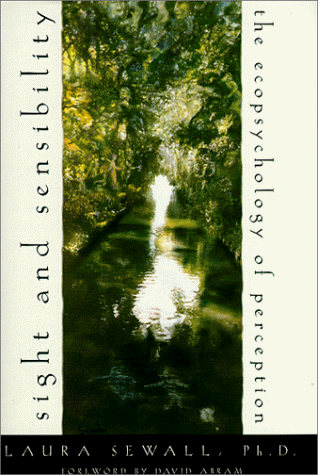Perhaps best continuing the train of thought from the 1990 philosophical classic, A Natural History of the Senses by Diane Ackerman, Sight and Sensibility is an exploration of the brains ability to adapt to the human sense of sight, and a strong argument for environmental factors being able to drastically shape our sense of sight. Laura Sewall is a self-described ecopsychologist, and her book’s argues that a reevaluation of the way modern man sees the natural world can drastically improve the way we fit into it.
There was a surge of renewed interest in environmentalism in the late 90’s. Sight and Sensibility found a strong audience response from people who believed the natural environment and the the human psyche are – or at least should be intertwined. IN he face of the natural world’s undeniable, wholesale degradation ecopsychology formed as an academic field. The best people to tackle humanity’s reintegration into the natural world are surely scientists, the movement posited, and ecopsychology was a term combining the science of the human mind and science of the natural world.
Laura Sewall, Ph.D., was one of my favorite ecopsychological pioneers. She is had already devoted her studies to physical and psychological visual processes and the leap to ecopsychology is enjoyably documented in this entertaining, surprisingly quick read. By combining these traditionally distant fields, she poses a comelling case that the sense of sight is not just a player but indeed the key to undoing decades of ecological devestation. Sight and Sensibility– is the earliest book I could find to use the term ecopsychology. It is especially useful for explaining the philosophical heart of scientific environmentalism.
The book uses examples from the author’s own fieldwork regarding visual predicaments, attitudes, habits and behaviours of wild baboons with personal observations from deep in the African continent. She expresses some excellent research about the evolution of human sight. Sewall also examines efforts from the psychological community to teach or reteach vision improvement. Finally, the captures several, varied cultural examples of different ways of using vision. She shows how we can restructure the neural networks that determine how we see, awaken to visual patterns and depth perception, and learn to see more of the world around us.
Sight and Sensibility at Amazon.com
Check out further reading on the subject:
John Berger’s classic Ways of Seeing(1972)
Diane Ackerman’s A Natural History of the Senses(1990)
|
Jonathan Howard
Jonathan is a freelance writer living in Brooklyn, NY |


